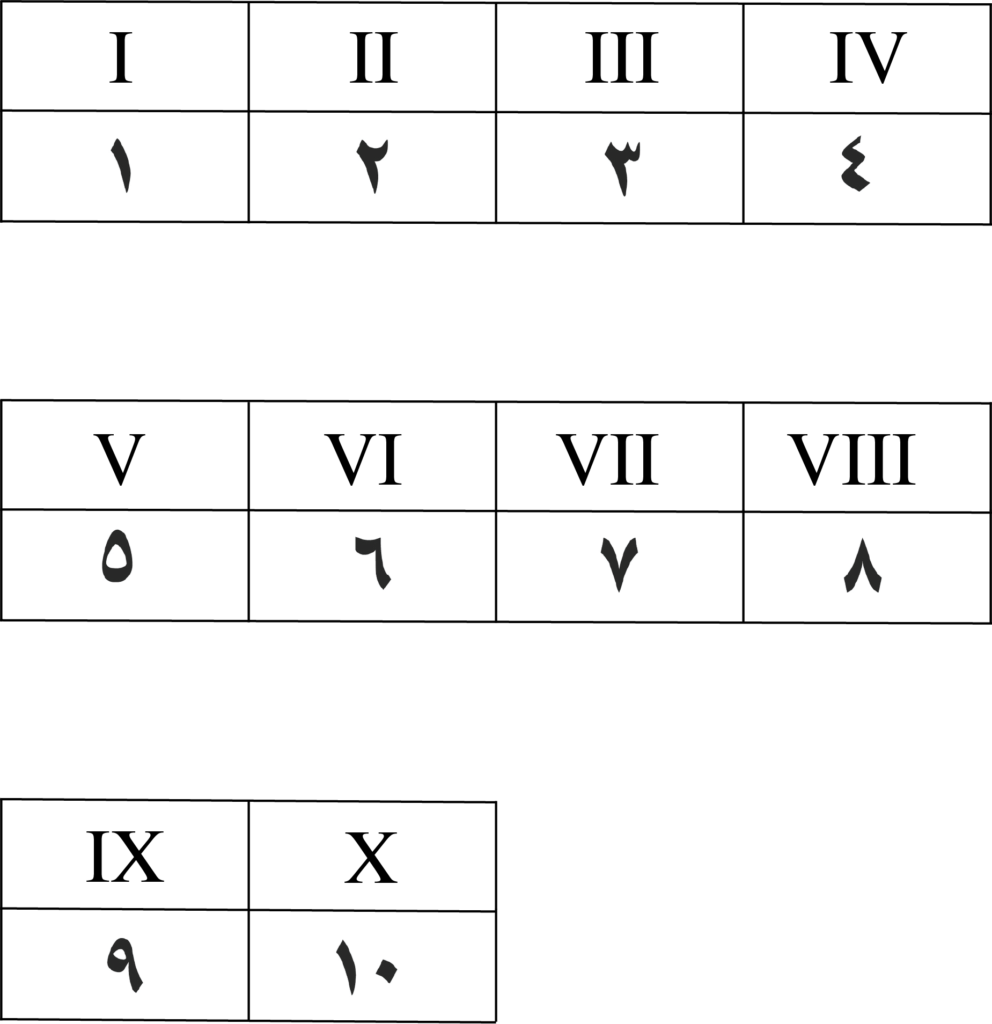Roman numeral chords are what we use in typical music analysis. Using Roman Numerals provides a great way to label chords in a piece of music as they include a lot of information about the chord, its quality, its inversion and more. Let’s explore this incredibly useful labelling system.
Roman Numerals
Roman numerals are simply another numbering system. In the western world we use the arabic numeral system to count. By this I simply mean 1, 2, 3, 4, 5, 6, 7 etc. Seem familiar? However, we do not use these arabic numbers in western music, instead we label each of the scale degrees using Roman numerals.
Below is a table to show the Roman numerals and arabic numerals written on top of each other so you can see how they relate to each other.

Writing Roman numerals can look slightly different depending on whether you are handwriting them or typing them. Typing them will look like the below:
I II III IV V VI VII
and handwriting them will add an additional line on top and beneath like so:

How do Roman numerals relate to scales?
Each Roman numeral directly corresponds to the scale degrees. Take a look at the c major scale below and see each of the scale degrees labelled with it’s corresponding Roman numeral written directly below.
All Roman numeral labelling stems from these scale degrees so it is extremely important that you are confident with these scale degree numbers before you use Roman numerals.

Using Roman numerals to show chord quality
Roman numerals can also show us the chords quality i.e. whether the chord will be a minor chord or a major chord. Major and minor chords are represented differently by using lowercase Roman numerals or uppercase Roman numerals.
A major chord will be indicated with an uppercase Roman numeral.
A major chord simply means triads (chords) built using a major third and a perfect fifth above the root.
Below you can see scale degrees 1, 4 and 5 of the C major scale. Above them we have written the major third and the perfect fifth above resulting in three major chords. To show that these are major we have written uppercase roman numerals I, IV and V.

A minor chord will be indicated with a lowercase Roman numeral.
A minor chord simply means a triads (chords) built using a minor third and a perfect fifth above the root.
Below you can see scale degree numbers 2, 3 and 6 from the c major scale.Above them we have written the minor this and the perfect fifth above, resulting in three minor chords. To show that these are minor, we have written lowercase Roman numerals ii, iii, vi.

What if the 5th is changed?
As we have seen in each chord above, every 5th is perfect but what if that changes? It is quite possible to have a diminished 5th or an augmented 5th. If we have a minor 3rd and a diminished 5th above the root our chord is then considered a diminished chord. In Roman numerals we represent this with a small circle next to the Roman numeral.
Below you can see chord 7 of the C major scale. This would be labelled with a lowercase vii to indicate the minor third in the chord and a small circle to indicate that we have a diminished 5th.

If we have a major 3rd and an augmented 5th above the root of our chord, then this is considered an augmented chord. In Roman numerals we represent this with a little + symbol next to the Roman numeral.
Below you can see chord 3 of the A Harmonic Minor Scale. This would be labelled with an uppercase III to indicate the major third in the chord and a + to indicate that we have an augmented 5th.

Roman numerals and their qualities in major and minor scales
In each scale, major or minor, the chords are different.
For major scales they are as follows:
I ii iii IV V vi viio

In a natural minor scale they are as follows:
i iio III iv v VI VII

In a harmonic minor scale the chords are as follows:
i iio III+ iv V VI viio
In A harmonic minor scale, we raise the seventh note meaning that the chords qualities will change.

Ear Training and Chords
To develop as a musician you’ll want to be able to recognise chords by ear. This is where ear training comes in. My recommendation for this is Tonegym as they have a comprehensive and fun program for training your ears! It’s what has gotten the best results with for my own students.
In the ‘tools’ section of their site, Tonegym even have a chord player that allows you to listen virtually any chord.
For an in-depth look at ear training, here’s my full review of Tonegym.

Roman numerals and seventh chords
Seventh chords are simply represented with a small number 7 next to the roman numeral.
When we utilize seventh chords we now open ourselves up to more possibilities as we have more notes in our chord. We now have the possibility of a half diminished chord (a minor 7th above a diminished triad) and this is represented by a small circle with a dash through the centre.
Let’s take a look at the major scale seventh chords
In a major scale the seventh chords would be as follows:
I7 ii7 iii7 IV7 V7 vi7 viiø7

In a natural minor scale the seventh chords would be as follows:
i7 iiø7 III7 iv7 v7 VI7 VII7

In a harmonic minor scale the seventh chords would be as follows:
i7 iiø7 III+7 iv7 V7 VI7 viio7

It is important to note that within Roman numerals, the major 7th chord and the dominant 7th chord have the same labelling.
Roman numerals and inversions
Roman numerals don’t just represent chord qualities but they can also help you to identify chords positions (inverted chords). Whether the chord is in root position, first inversion, second inversion or third inversion, Roman numerals can help indicate this as well.
In the UK, we use a small letter after the Roman numeral to indicate the chords position.
A small letter ‘a’ indicates root position (although the a is often omitted.)
A small letter ‘b’ indicates first inversion
A small letter ‘c’ indicates second inversion
A small letter ‘d’ indicates third inversion (only used in the case of seventh chords)
Take a look at Chord I from the G major scale written and labelled in three inversions.

It is also possible to use figured bass written next to the Roman numeral.
We write 5/3 to indicate root position (although this is often omitted)
We write 6/5 to indicate first inversion
We write 4/3 to indicate second inversion
We write 4/2 to indicate third inversion.
We write See below chord I of the g major scale written in all three inversions and labelled in this alternative way:

This way of representing inverted chords simply borrows another chord labelling system called figured bass. To learn more about this you can click here.
How to do Roman numeral analysis
Roman numeral analysis is the analytical procedure of looking at music within the context of key signatures.
In order to do roman numeral analysis you need to take into account a few things:
- What key is your piece in?
- If the chord you are looking at is inverted then you want to mentally stack the chord into root position as it will be easier to label
- Identify all the notes of the chord
- Write down the roman numeral that corresponds with the scale degree and quality of the chord
- Add any additional symbols
- Add either the small letters or the figuring to show the chords position.
Roman numerals are an excellent way to label each chord. Roman numerals can represent minor chords, represent major chords, show the chord quality, show whether you have diminished chords, augmented chords and also show whether your chord is inverted. Learning this roman numeral labelling system is extremely important in music theory.
What’s next….
- Learn more about the different types of chords in our complete guide.
- Learn about seventh chords in more details.
